Undergraduate Students Thrive Through Collaboration in the Cotsen Institute Labs
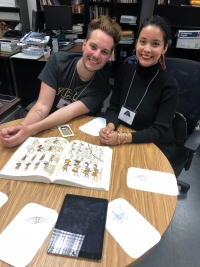
A.J. Meyer and CJ Zepeda
Collaboration has always been a keystone of the Cotsen Institute, and Stella Nair, professor in the Department of Art History and core faculty member of the Cotsen Institute, has seen proof that undergraduate students working with graduate students in the laboratories of the Cotsen Institute can create a valuable outcome for both. When Nair took over as director of the Andean Laboratory and established the Architecture Laboratory about two years ago, she knew that she wanted to create a space that allowed more students to work comfortably on their own projects, as well as find support from other students with similar interests. The graduate students who had been using the Andean Laboratory worked tirelessly to help reorganize the space now used by both laboratories to accommodate smaller desks, new equipment, and even a small kitchen. The smaller desks allowed more students to share the space, and Nair started to invite select undergraduate students, primarily those who were pursuing honors theses with her.
Nair explained that she wanted to develop a community that was a place for students to focus not only on their own scholarship, but also engage with others in challenging and supportive ways.
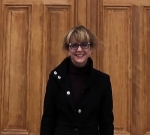
Stella Nair
In particular, Nair wanted to break down the barriers that exist between advanced undergraduate researchers and graduate students. Although she has her own projects, she noted that “the students and their projects are given priority. There has been no competition between graduate and undergraduate students. They really take care of and learn from each other.” Most of the students study directly with Nair; she is their advisor on their dissertations or honors thesis or on their committees. However, other students on campus who have a serious interest in the topics of either laboratory can also be members. Besides having a work space, undergraduate students can also take part in the two working groups run by graduate members of the laboratory: the Andean Working Group and the Architecture Working Group (both officially sponsored by the Cotsen Institute).
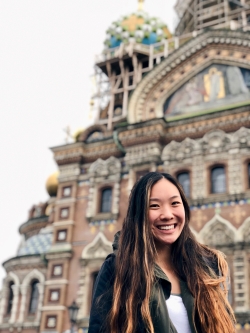
Emilie Liu
Several recent undergraduate students truly exemplified the elevated level of study possible through collaboration, Nair pointed out enthusiastically. Emilie Liu, who graduated at the end of the Winter quarter with a double major in art history and neuroscience, was doing “completely original work that was very exciting,” according to Nair. Liu had been chosen by the Department of Art History to give the lecture during the Undergraduate Research Week, which has now become a pre-recorded presentation to be posted on the Undergraduate Research Week website mid-May. The presentation will cover her senior thesis on “Manipulating the Senses and Making Art: An Analysis of Inca Vilca Usage.” Vilca is a hallucinogenic compound mentioned in literature discussing the Inca. “Because professor Nair is an Inca specialist, she suggested that looking at hallucinogens might be a good way to combine my background in neuroscience and my interest in art history,” Liu explained.
“I would not be where I am in my research without the other students in the Andean laboratory,” Liu pointed out. After being invited by Nair to join the lab, Liu found that the best use of this ”great workspace” was the interaction between undergraduate and graduate students. “The graduate students were so helpful, giving me feedback, advice, edits, and guidance. Just having that support system and getting input from people who are so well-versed with such a strong background in the Andes,” was extremely valuable to her. She was initially intimidated because she had seen many of the graduate students when they were serving as teaching assistants in Nair’s undergraduate classes. “It was definitely interesting seeing that shift from having them grade our papers to actually being able to join in the conversation; having them act as mentors,” she added.
Liu had previously worked in two more traditional, scientific laboratories during her neuroscience studies, but never in a humanities laboratory. “This is more of a gathering space, as well as a work space. It feels like a place where you can come to discuss ideas, and if you have a question, someone is there.” Although she worked with several graduate students, she noted that she worked most closely with Louise Deglin, a doctoral candidate in the Department of Art History specializing in the Arts of the Indigenous Americas. “She was always so reliable and responsive. She has been really kind and helpful and a really great mentor. She actually gave me some resources that I ended up integrating into my thesis in order to establish the use of hallucinogens and the depiction of that in terms of iconography that has been prevalent throughout the region and time period,” Liu explained. “She also voiced potential concerns that academics may have with my work, things that I needed to address before presenting my thesis.”
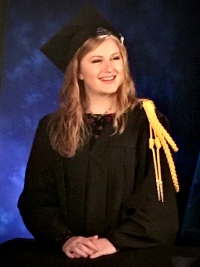
Hope Noakes
Hope Noakes is another member of the Andean Laboratory who is doing “great new research,” according to Nair. Noakes will graduate in June and hopes to spend some time studying Spanish and traveling after graduation before going on to graduate work in art history. Her honors research “could easily develop into a fascinating dissertation topic,” according to Nair. She originally had taken Nair’s class “Art and Architecture,” and it triggered an interest in Inca culture. She had studied the Maya and the Aztec at Orange Coast College before transferring to UCLA. Nair talked to her about the honors thesis and got her interested in the topic of gender and Inca culture. While Noakes was doing her research, she because fascinated with Incan artifacts featuring feathers in the collection of the Metropolitan Museum of Art in New York. She told Nair about her interest and discovered that no one had really studied feathers in the context of gender within Inca material culture. So she set about finding her own examples. Her studies eventually resulted in her honors thesis: “Inca Women of Feathers and Power: Capacocha Feather-Work and Figurines.”
She was able to use the laboratory as a home base, which was especially important for her. Noakes lives in Orange County and was commuting to UCLA three times a week. Often, she would stay on campus until 8 p.m. to avoid most of the traffic so as not to increase her hour-and-a-half drive each way. The laboratory gave her a personal space and a place to work, as well as the ability to work with the graduate students. She presented her lecture to the graduate students, and “they really helped me with feedback; advising me not to make a lot of grand statements, but to qualify them. It was extremely useful to get input not only on my presentation skills, but on my research,” she added. If she had a question, she would ask whomever was in the laboratory at the time. One of the best contributions came from PhD candidate Georgi Kyorlenski, who is a member of both the Andean Working Group and the Architecture Working Group. He helped her with a link to a Colonial Spanish dictionary, which was particularly important because Noakes does not speak or read Spanish. She hopes to change that with her studies later this year. Eventually, she would like to do museum work with indigenous collections.

CJ Zepeda
Surprisingly, an undergraduate student who is going on to a film career was one of the stars of the Architecture Laboratory, according to Nair, who referred to CJ Zepeda as a “creative genius.” In Zepeda’s film studies, she was doing research about how Mexican directors making films for a North American audience took influence from Mesoamerica and how they incorporated this influence into their films. She approached Nair to help guide her through the process because she was unfamiliar with the “deep history” of Mexican culture. She was aware that films such as “Coco,” “La Llorona,” and “The Book of Life” showed ancient buildings in their films, and she wanted to know how realistic these depictions were. “I did not have any background in archaeology, anthropology, history, or anything in the sciences. My focus has always been in design in film, so this was a whole new territory for me,” Zepeda explained. “And I knew I could make something in augmented reality.
“I wanted to display research in augmented reality so that people could interact with these structures; pick up an iPad and move it over the hieroglyphs,” for example. “Professor Nair saw this work as it was developing, and she invited me to join the 2019 Open House of the Cotsen Institute together with the graduate students from the Architecture Laboratory,” Zepeda continued. “I was really nervous because I felt I had no business being in graduate presentations of any sort, especially in a field I previously had nothing to do with. So when I showed up, professor Nair introduced me to A.J., whom I had briefly spoken with earlier and who had given me some tips on what to do and how to properly portray the information.” A.J. Meyer is the coordinator of the Architecture Laboratory and a doctoral candidate in art history.

Zepeda showcasing AR tool
“I just wanted to be in the background. But for some reason, A.J. and the other graduate students were very welcoming to my work and how I was able to present research and have people interact with visuals of the Mesoamerican culture using art and technology.” According to Nair, Zepeda’s presentation was the hit of the Architecture Laboratory during the Open House. Zepeda discovered that she really liked what the graduate students were doing and that she had many ideas on how by working with them she could create a way for people to “enter” these projects. “The graduate students did not know how to do it, and I did not know about their research,” but working together was “a perfect fit,” Zepeda said. She proceeded to join the laboratory and help out graduate students with her expertise. “Everyone has such cool and amazing projects. But as a senior in the design department, I cannot take on too many projects right now,” she explained.
One of the projects she is working on with a graduate student is the digital three-dimensional model of what a hall could look like, based on images and explanations provided by Louise Deglin in the Andean Laboratory. “I am very passionate about the work that the graduate students are doing,” she added. “I definitely would like to reconstruct some of the structures that they are working on.” She is currently working with Deglin online and getting a lot of advice from Meyer. She is also in contact with Alba Menéndez Pereda, one of the coordinators of the Andean Laboratory. Zepeda will graduate in June and start an MFA at USC in the Fall, but she hopes to stay in touch with her collaborators in the Architecture and Andean Laboratories.
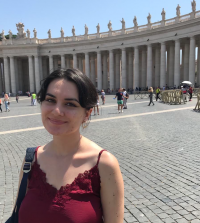
Miranda Claxton
One undergraduate student who was invited to join the Andean Laboratory, but never got to use the physical space because of the campus closure, is Miranda Claxton, who is “keeping the collaboration going, even during the pandemic,” according to Nair. Claxton is scheduling a Zoom lecture in May where she will present a lecture to all members of the laboratories to generate feedback and help her move her project forward. “This shows one way that we can all meet up digitally and share how things are going, even if we cannot be in the same space together,” Nair continued. “I want to make sure that no one falls through the cracks and to remind everyone that we are all here to support and assist each other, however needed. This will also start some great conversations about music, sound, and gender in the Inca world,” Nair added. Claxton’s thesis on: “Sounds of the Empire: Female Voice and Song in the Inca Empire” is another example of “important new discoveries about the Inca,” according to Nair. Claxton is investigating the role of women as musicians in the Inca Empire. “Women would perform songs or drumming for ritual celebrations,” she explained. “Songs were very significant in the Inca Empire as part of oral tradition; they were important in retelling history or marking special celebrations. Included in my investigation was whether or not these women had any agency in the way they performed or even in creating the songs,” she added.
Nair hopes that the laboratories will expand in three ways. First, “to create a collaborative space where students interested in research can share ideas and support one another, from formal working and reading groups, to creating spaces for independent work and informal gathering and discussion. Second, where we can have collections that they can use in their research and which can be accessible to visiting scholars and volunteers. Third, we will have architecture equipment and do experiments relating to construction,” Nair explained. “While it will take a while to build our collections and obtain equipment, we already have made a great start with the first goal: building up a great team of graduate and undergraduate students and a post-doctoral research affiliate, for the exchange of ideas in working groups, lecture series, and informal exchange.”
Published on April 24, 2020.


